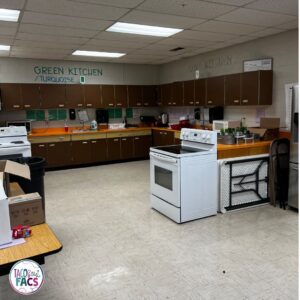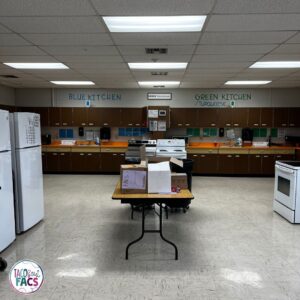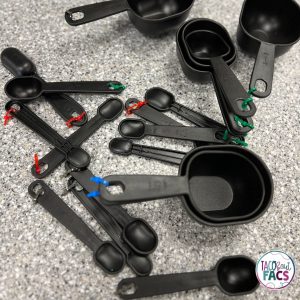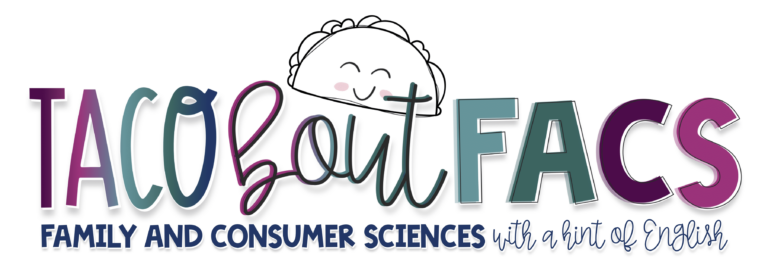If I had a dollar for every time we were in a cooking lab and I heard a student ask, “Where is ___?”…well, I’d be rich enough to purchase a private island. Can you relate?
There are times students cannot find something in plain sight, but there are also times utensils made it to an entirely different kitchen.
Trying to figure out easy-to-follow, inexpensive, and effective organizational hacks for 5 residential Family and Consumer Science kitchens can be quite the task! And to quote The Lazy Genius, I needed “to be genius about the things that matter and lazy about the things that don’t”.
What does this look like in the FACS kitchens?
While I dream of days where every plate, cup, and bowl has an exact place, I know that’s not realistic for 7th and 8th graders. Nor is that even worth my energy to patrol.
I do, however, have a strong belief that the entire measuring cup and measuring spoon set should be in each kitchen, each time it is needed.
Even with the best of intentions, when 150 students are rotating through a day or two of cooking labs, one needs some organizational hacks!
Organizational hacks for classroom kitchens
Color coded kitchens
It started with color coded kitchens. For the most part, students knew where to put things, but you can’t always find the correct color bowls, measuring sets, etc. When my kitchens were renovated, I also went as far as naming my kitchens with color coded names.
Naturally, my 8th graders rolled their eyes about the names, but they sure became quite particular about their kitchen and making sure the appropriate utensils were in place. This was a win- color coding and naming the kitchens.


I have 5 kitchens. The names and colors are fun and cheesy, but oh so fun! It is true that when you assign names to an inanimate classroom object, it receives better care.
Purple- Lebron Jams
Red- Red Sheeran
Blue- Whitney Blueston
Green- Elvis Parsley
Gray- Rice Witherspoon
Side note- I also name all of my sewing machines. It’s a game-changer for using the same sewing machine and troubleshooting which ones need repair.
Measuring cups and spoons
Finding an inexpensive set of measuring cups and spoons that match the color coded kitchen was out of the question
I opted for the inexpensive sets from Walmart, but that also means each set is black.
To help fix this problem, I use colored zip ties on the ends of each measuring cup and measuring spoons. It’s a simple and fast fix. It is also an easy way for students to put the appropriate utensil back in a kitchen if it is left on the prep table or gets misplaced.

Amazon has quite the inventory for colored zip ties. If your kitchens classic colors or even neon, they have you covered.
Recipe holders
I have found you can print recipes for every student and still have kitchens begin cooking with a recipe.
I’d like to believe the prep work before the cooking day prepared them enough, but I also teach 7th and 8th graders, so I am aware that “winging it” isn’t a great plan for them.
Introducing recipe holders. Simple plastic holders that give each kitchen a common expectation of where to find their recipe. No more looking around to see who moved it. Plus it also keeps the page clean and easy to read.

Sometimes I am ahead of the game and will add a copy to each kitchen’s recipe holder the morning of the lab, but my 1st hour is always great to seamlessly fill the gap if needed.
I also prefer paper copies of the recipe in a holder over a Chromebook in the kitchen. Knock on wood– there haven’t been any kitchen accidents with a Chromebook, but I also know how filthy those are and not having them on the kitchen counter is ideal.
Plastic trays
Simple plastic trays are one of the best investments for cooking and sewing units. These durable trays also come from Amazon. Each kitchen has 3-4 trays.
The trays are used to gather ingredients from the prep table and also to deliver the guest judge plate.

The tray provides a more professional appearance for the delivery and allows for the napkin, utensil, salt and pepper.
The same trays double as a table placeholder for certain sewing tools. This makes is that much easier to make sure all supplies are collected at the end of the hour as well as putting out supplies in the morning. You can read more about sewing organization here.
Colored equipment
It has taken some time and still a work in progress, but buying color coded pots and pans, mixers, plates, bowls, etc has been a great investment.
This might not work in the FACS industrial kitchens, but for the home kitchen set-up, this is another way for students to visually see which things go where.
Rachel Ray has a great selection of color coded pots and pans. It is also a quick fix when one kitchen claims they don’t have specific pots or pans and another kitchen opens their cabinets showing a different color.
For many of my students, 7th and 8th grade FACS is the intro to the kitchen or students come with limited kitchen experience. The equipment and utensils in the classroom kitchens are similar to what they would have at home.
Walmart also has inexpensive plastic plates and bowls in various colors. This has been an ongoing purchase as the colors change for the season and match the kitchen colors.
And a bonus- colored paper
Every cooking lab includes a guest judge. Guest judges have been prepped ahead of time that the privilege of eating means they have to provide feedback.
Using a consistent colored copy paper means the guest judge always knows to expect a green quarter sheet of paper and easier for students delivering to know they also need to take the paper.

I use the feedback the day after the lab to discuss positives and ways to grow. I can quickly find green pages if my desk isn’t quite organized and guest judges drop off feedback when I’m in the kitchen.
You could choose any color, but keeping a consistent color provides routine. So much so, I was standing in the lunchroom holding feedback forms I had picked up in my mailbox. I had students eye the paper in my hands from across the lunch room and come over to see if it was for their kitchen.
If you haven’t listened to The Lazy Genius podcast, you’re missing out. Kendra Audachi has inspired all things “Lazy Genius” for my classroom. There are so many things to organize in a FACS classroom. Organizing the kitchen means being genius about the things that matter- – getting the correct utensils in the correct kitchen- – and lazy about the things that don’t. While this isn’t a sponsored post, Kendra’s philosophy relates perfectly to the systems of operation in every classroom!

